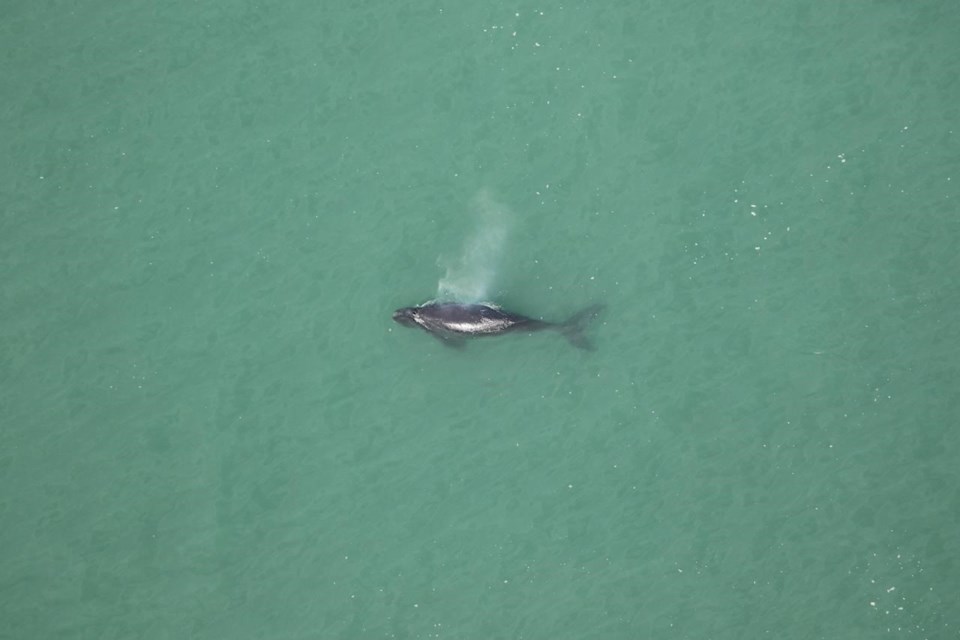FREDERICTON — The recent death of a weeks-old endangered North Atlantic right whale is a blow to the fragile species, say researchers.
The calf was found dead Jan. 7 under a pier in Beaufort, N.C., and had been swimming alone without its mother anywhere nearby, Philip Hamilton, senior scientist with the New England Aquarium’s Anderson Cabot Center for Ocean Life, said in an interview.
"Mothers and calves don't stray from each other when the calves are so young," he said. "Something may have happened to the mother or there was confusion, they got separated .... But it would not have survived for more than a few weeks without being fed."
There are about 340 right whales in existence and every calf is valuable, Hamilton said.
The animal's death occurred as the federal Fisheries Department extended its deadline to require that fishers use so-called "break-free" gear that helps prevent entanglements with whales. Entanglements are one of the main risks to the safety of right whales.
Brett Gilchrist, the Fisheries Department's director of national programs, said the implementation timeline was supposed to be Jan. 1 but it was extended to next year. He said there are concerns the gear could break prematurely and leave debris in the water, threatening the safety of marine life.
Break-free gear — or low-breaking-strength rope — is made to snap at 1,700 pounds of force, making it easy for large, entangled whales to free themselves.
"Ironically, it actually requires the whale to become entangled to work," Gilchrist noted.
He said his department is consulting with officials in the United States to get a better understanding of the effectiveness of the equipment.
"Lower-breaking-strength rope will help it break free, potentially, if it's a large, powerful and healthy adult whale. Smaller whales or adolescents or juveniles wouldn't benefit."
Kim Elmslie, campaign director with Oceana Canada, a non-profit dedicated to ocean conservation, welcomed the federal government's decision to hold off on requiring fishers to use break-free gear.
Fishers, she said, should instead be required to use gear that isn't composed of ropes at all.
"There isn't a lot of research out there that demonstrates that lower-breaking-strength gear works," she said in an interview. "For lower-breaking-strength gear to do what it's supposed to do, a whale needs to be entangled in it, right? That's problematic. It's a bit of a mitigation tool. It's not a prevention strategy."
Putting money and effort into advancing ropeless gear will be a win-win for fishers and whales, she said. "We want a way that whales and fishing can coexist in the (Gulf of St. Lawrence) and ropeless gear is that way."
Meanwhile, the website of the Washington, D.C.-based National Oceanic and Atmospheric Administration, which tracks right whales, said the calf was seen dead Saturday. The animal's death will be included in a list of right whales killed in "unusual mortality events," which involve vessel strikes and entanglements.
Hamilton said pictures and video of the animal show it to have been underweight and in poor health. A necropsy report will help identify cause of death, which could be starvation or drowning, he added. “Those are the two likely causes of death."
Tissue samples from the calf's necropsy will be sent to Saint Mary's University in Halifax to see if researchers can find the mother, he said.
"This population is fairly inbred; there's not a large amount of genetic diversity," he said.
"If it has a sort of common genetic signature, we may never know who the mother is."
North Atlantic right whale calves are born between mid-November and mid-April, and so far there have been 11 babies born this season. Fewer than 100 of the 340 surviving animals in the waters along Canada's eastern coast are mothers.
The biggest threats to North Atlantic right whales involve being hit by large shipping vessels and becoming entangled in fishing gear as they travel from the warm waters around Florida, where they are born, to the Gulf of St. Lawrence, Hamilton said.
"We love seeing the calves being born, and then we pray that they make a safe journey up to the northeast."
This report by The Canadian Press was first published Jan. 12, 2023.
Hina Alam, The Canadian Press


